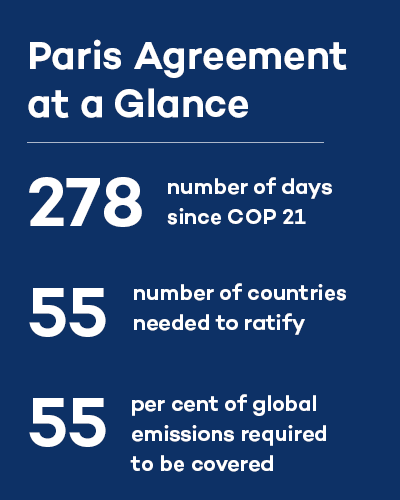A historic day as Paris Climate Agreement crosses a critical threshold
The global commitment to slowing the pace of climate change culminated today with the European Parliament approving the ratification of the Paris climate agreement thereby enabling its entry into force this week.
The historic agreement, adopted by 185 nations in the French capital last December, required ratification by 55 countries contributing to at least 55 per cent of global greenhouse emissions before coming into effect. With the European Union expected to deposit its ratification instruments on Friday, those thresholds will be crossed.
“Ratification of the Paris agreement has moved through national capitals with remarkable speed,” said Frédéric Gagnon-Lebrun, IISD’s program leader on climate change mitigation. “It’s a striking departure from past practice in international climate change negotiations and demonstrates the significant buy-in from countries that continues to build following the adoption of the agreement last December.”
 “The environment has not eclipsed the political primacy of jobs and the economy. What’s changed, however, is the mainstream understanding that these priorities are incompatible with catastrophic climate change,” said Gagnon-Lebrun.
“The environment has not eclipsed the political primacy of jobs and the economy. What’s changed, however, is the mainstream understanding that these priorities are incompatible with catastrophic climate change,” said Gagnon-Lebrun.
Countries will turn to the task of developing the rulebook that will guide the implementation of the agreement when they gather for the UNFCCC’s Twenty-second Conference of the Parties (COP-22) in Marrakesh, Morocco, from 7-18 November. “With the Paris Agreement now into force, the Marrakesh conference will go down in history as the first meeting of the Parties to the Paris Agreement,” said Gagnon-Lebrun.
"The Paris Agreement is an important victory towards preventing the worst effects of climate change," said Anne Hammill, director of IISD's resilience program. "But in order to prepare for the climate change impacts that our greenhouse gas emissions to date will cause, we hope all countries take urgent action on the Paris agreement's call to engage in adaptation planning and implementation."
In parallel, all countries now need to diligently start the hard work of implementing the climate change plans presented ahead of COP-21 in Paris, known as Nationally Determined Contributions, as well as mechanisms to report back to the international community on progress made.
About IISD
The International Institute for Sustainable Development (IISD) is an award-winning independent think tank working to accelerate solutions for a stable climate, sustainable resource management, and fair economies. Our work inspires better decisions and sparks meaningful action to help people and the planet thrive. We shine a light on what can be achieved when governments, businesses, non-profits, and communities come together. IISD’s staff of more than 250 experts come from across the globe and from many disciplines. With offices in Winnipeg, Geneva, Ottawa, and Toronto, our work affects lives in nearly 100 countries.
You might also be interested in
Unlocking Supply Chains for Localizing Electric Vehicle Battery Production in India
This study aims to highlight the key supply chain barriers in localizing electric vehicle (EV) battery cell manufacturing in India. It summarizes consultations with 12 companies, as well as experts and policy-makers, to determine the crucial challenges and opportunities in localizing battery manufacturing in India.
What Is the NAP Assessment at COP 29, and Why Does It Matter?
At the 29th UN Climate Change Conference (COP 29) in Baku, countries will assess their progress in formulating and implementing their National Adaptation Plans. IISD’s adaptation experts Orville Grey and Jeffrey Qi explain what that means, and what’s at stake.
COP 29 Must Deliver on Last Year’s Historic Energy Transition Pact
At COP 29 in Baku, countries must build on what was achieved at COP 28 and clarify what tripling renewables and transitioning away from fossil fuels means in practice.
IISD Welcomes Draft Regulations for Oil and Gas Pollution Cap
A firm cap on emissions can provide certainty for industry to invest in decarbonization, while ensuring the sector is on a path to net-zero by 2050.